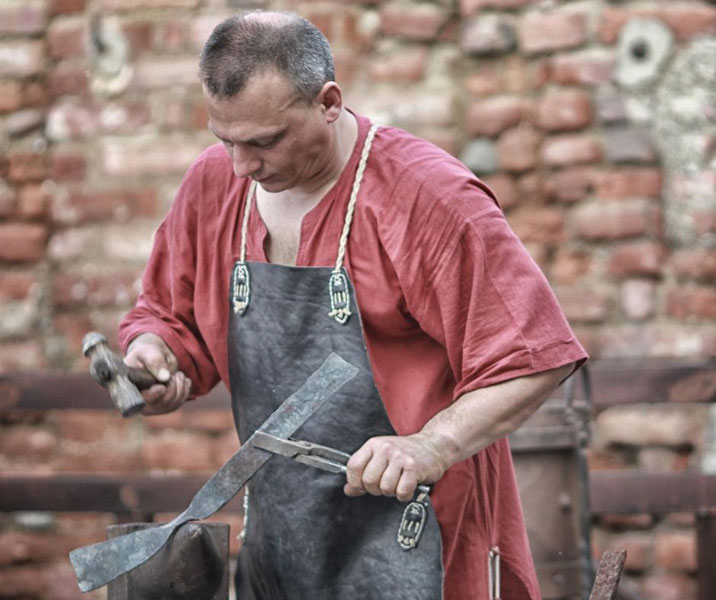The fascinating history of surnames: Where does your family name come from?

Everyone has a surname. It connects us to our family history and carries information about our ancestors, which include their backgrounds, occupations, cultures and places of origin.
Yet, the historical backdrop of these enduring monikers often escapes our attention.
The historical origins of last names
Surnames are a relatively recent development in human history. For thousands of years, most people only had one name.
In small communities, a single given name was usually enough to tell people apart.
As populations grew and societies became more complicated, however, the need for clearer naming grew.
This led to the slow introduction of extra name additions. In Chinese legend, hereditary surnames are said to have originated as early as 2852 BCE under the legendary Emperor Fu Xi, who is said to have introduced them so families could see clear lineage and maintain social order, though recorded use began much later under historical dynasties.
Early Chinese surnames such as Ji (姬) and Ying (嬴) were linked to noble houses and became key aids for government.
In Europe, the practice spread more slowly. By the 11th century, the Normans began to introduce fixed family names to England after the conquest of 1066, particularly among the nobility, although their use among commoners only became widespread several centuries later.
The use of surnames became more official as governments and church organisations began to keep written records.
This was particularly evident after the Council of Trent (1545 to 1563), which required Roman Catholic parishes to record each baptism and marriage, as well as every burial.
In England, Henry VIII’s break from Rome in the 1530s resulted in the Church of England keeping its own parish registers.
This led to the 1538 royal injunction issued by Thomas Cromwell, which required parish record-keeping.
By the 16th and 17th centuries, surnames in many parts of Western Europe had been passed down through generations and become fixed in spelling and use, though in some regions this process occurred earlier or later based on local customs and organisations.
In other parts of the world, such as among Indigenous Australian and Native American groups, surnames as used in European systems were not traditionally part of naming practices.
How they developed in different cultures
The evolution of surnames varied widely depending on local customs and languages. It also showed social differences.
In many parts of the Islamic world, for instance, names followed a patronymic system but also included religious or tribal identifiers.
A man might be known as "Ibn Abdullah", meaning son of Abdullah, followed by a place of origin or family lineage.
Common historical examples include names such as Abdullah ibn Abbas or Fatima bint Muhammad.
In ancient Rome, the use of the tria nomina system: praenomen, nomen, and cognomen, offered an early form of surname, particularly for elite citizens.
For example, "Gaius Julius Caesar" identified his personal name, his gens or clan, Julius, and his family branch, Caesar.
However, plebeians often lacked this full structure.
In Slavic cultures, surnames often included suffixes that indicated family relationships or origins based on places.
Russian surnames like Ivanov, Petrov, or Sokolov derive from the father’s name with the addition of "-ov" or "-ev," which meant "belonging to.""
In Ireland and Scotland, surnames were also patronymic but took different Gaelic forms such as "Mac", meaning son of, and "O'", meaning descendant of. For instance, "MacDonald" originally meant "son of Dòmhnall."
In East Asia, family names often came before given names, a pattern still seen across modern East Asian naming conventions.
In Japan, surnames only became common after the Meiji Restoration when the 1875 Family Registration Law known as the koseki system required all citizens to adopt fixed surnames.
The main types of surnames: which is yours?
Most surnames fall into one of four broad groups: patronymic, occupational, toponymic, and descriptive.
Each of these types reveals something about the person or family who first used it.
A surname might indicate a person’s parentage, trade, geographic origin, or even a distinctive trait.
In societies where few records existed and few people could read, these identifying terms served as useful tools for both the community and officials.
A fifth category, that of imposed or adoptive surnames, also emerged where names were assigned due to colonial, religious, or political intervention.
Identifying the type of surname one carries can uncover clues about an ancestor’s life.
For example, someone named "Hill" may come from a family who lived near a hill, while the surname "Smith" points to ancestors who likely worked as blacksmiths.
These categories offer a useful starting point for anyone tracing their surname and understanding how it fits into broader naming patterns.
1. Patronymic Surnames
Patronymic surnames derive from the personal name of a father or grandfather.
These names are especially common in societies where lineage and inheritance followed the male line.
In Scandinavia, surnames like "Andersen" or "Johansson" originally meant "son of Anders" or "son of Johan."
Iceland continues this tradition today using a living patronymic system rather than fixed family surnames.
A man named Ólafur with a son named Erik would pass on the surname "Erik Ólafsson," while his daughter would be known as "Eriksdóttir."
In the Middle East, Arabic names often used "ibn" (son of) or "bint" (daughter of) followed by the father’s name.
In Eastern Europe, Slavic naming patterns used suffixes like "-ovich" or "-evich" for sons and "-ovna" or "-evna" for daughters.
In the British Isles, patronymics were the foundation of names like "Harrison" (son of Harry) and "Fitzgerald" (son of Gerald), the latter from Norman French.
Biblical naming conventions also show early examples of this system, as in "Simon bar Jonah" or "Joseph son of Jacob."
Over time, these names became hereditary and no longer changed with each generation.
2. Occupational Surnames
Occupational surnames indicate a person’s trade or profession. They were among the first surnames to become common in towns where several people might share the same first name but work in different fields.
In England, "Smith" became one of the most common surnames due to the widespread presence of blacksmiths.
Other examples include "Baker," "Carter," "Fletcher," arrow maker, and "Cooper," barrel maker.

In France, occupational surnames such as “Boulanger” (baker) or “Charpentier” (carpenter) became common by the later Middle Ages, with some that showed up by the 1100s.
The same occurred in Germany with names like “Schneider” (tailor) and “Müller” (miller).
In Japan, some surnames adopted during the Meiji period, such as “Tanaka” or “Kobayashi,” might refer to jobs, though many came from place names.
In India, titles such as “Chowdhury” were sometimes linked to land ownership or local jobs, especially in Bengal and northern areas, instead of a specific trade.
Occupational surnames show the work ancestors did when family names became common.
3. Toponymic Surnames
Toponymic surnames come from places. These could refer to a town, village, natural landform or landmark associated with the individual or their family.
In Norman England, surnames like “de Clare” or “de Warenne” identified individuals by the estates or regions they controlled.
As surnames spread to the lower classes, more common toponymic names appeared, such as “Hill,” “Wood,” or “Marsh.”
These names also showed how people moved. A person who moved to a new town might be called by the name of their old one, such as “London” or “Kent.”
In Italian, names like “Di Napoli” or “Fiorentino” show where a family came from, such as Naples or Florence.
Spanish surnames such as “Del Rio” (of the river) or “Montoya” (from the hills) come from similar places.
German examples include names like “Berliner” or “Schwarzwald,” while Slavic toponymics such as “Krakowski” indicate origin in Kraków.
These names give hints about where families moved and once lived.
4. Descriptive Surnames
Descriptive surnames refer to a physical characteristic, personality trait, or other identifying feature of an ancestor.
These were less common than other types, but still formed a large share of surnames across medieval Europe.
Names such as “Short” and “Brown” described someone’s appearance, and the surname “Strong” showed a strong build.
In French, the surname “Legrand” indicated someone tall, while “Blanc” referred to someone with light hair or skin tone.
Sometimes these descriptors could be misleading, like in the case of someone called “Little”, who may have been quite large.
Others showed personal traits or reputation, such as “Stern” or “Wise.” In Scotland, the surname “Cameron” derives from the Gaelic cam-shron, which meant “crooked nose.”
Other examples such as “Armstrong” and “Petit” show strength and stature. The name “Goodfellow” conveys a friendly nature.
Political and religious influences on names
Religious conversion and takeover often changed surnames. When people blended in, surnames often changed or new ones were forced upon populations.
During the Spanish Inquisition, Jewish and Muslim families who converted to Christianity were pushed to take new family names to show loyalty, such as “Santa Cruz” or “Delgado.”
In Eastern Europe, Jewish surnames became widespread in the late 18th century, when Habsburg and Russian authorities ordered Jewish subjects to take lasting family names for tax and army records.
In 1787, Emperor Joseph II of Austria issued an order making Jews take German family names.
Inconsistent spelling arose because clerks recorded names by how they heard them.
Pronunciations differed across regional accents and affected how names were written.
Errors made during administrative recording also altered surnames over time.
Before the 19th century, few people spelled their names consistently, and clerks often recorded what they heard phonetically.
This resulted in multiple versions of the same name. For instance, the surname “Clark” might appear as “Clarke,” “Clerke,” or “Clerk” in various documents.
The English pronunciation of the French-origin name ‘Beauchamp’ became "Beecham," showing how greatly names could vary in spelling and sound.
Migration introduced further changes. When immigrants entered English-speaking countries, they sometimes simplified or altered names to make them easier to pronounce or spell.
A German name like “Schmidt” might become “Smith,” or “Mueller” might become “Miller.”
Ellis Island is often believed to be a site of such changes, though name alterations typically occurred through choices made willingly by immigrants themselves, either during the immigration process or later in an effort to fit in.
Some names were changed deliberately to avoid unfair treatment, especially during the 20th century.
These changes have created wide branches in surname records. This development has made historical tracing more challenging and more interesting.
Tracking your family's surname over time
Tracing the history of a surname can provide insight into family history, geographic movement, and social status.
Church registers, census returns, immigration documents, and military records are valuable sources for this task.
Genealogists use these records to follow a name’s appearance through generations, often discovering unexpected variations or previously unknown relatives.
In Britain and Ireland, the censuses from 1841 to 1911 offer detailed surname information, while in Australia, early convict and land grant records are especially useful.
Other helpful databases include the International Genealogical Index (IGI) and FamilySearch.
DNA testing and online genealogy websites have further expanded the ability to trace surnames across centuries and continents.
When one combines language study with historical documents, one can pinpoint a surname’s original form and meaning.
DNA surname projects that use Y-chromosome data allow researchers to track shared paternal ancestry.
Whether your name originated from a blacksmith’s forge, a highland croft, or a small village in Normandy, the history of your surname connects you to a long and traceable human story.
What do you need help with?
Download ready-to-use digital learning resources
Copyright © History Skills 2014-2025.
Contact via email
With the exception of links to external sites, some historical sources and extracts from specific publications, all content on this website is copyrighted by History Skills. This content may not be copied, republished or redistributed without written permission from the website creator. Please use the Contact page to obtain relevant permission.





